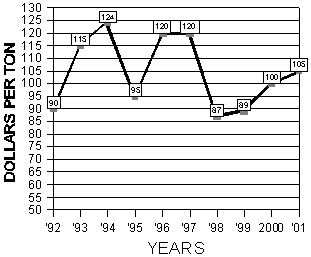Alfalfa Report
Yuma County, Arizona
December 17, 2001
Yuma County Office
2200 W. 28th Street, Ste. 102
Yuma, AZ 85364
(928) 726-3904
(928) 726-8472 FAX
Production Update:
PDF version, 61KB
Winter irrigation termination: Water can be conserved in alfalfa production by not irrigating during the winter. In a test conducted on the Yuma-mesa, alfalfa irrigations were terminated from November through February with only a slight impact on yield. Winter rainfall is often sufficient to maintain some growth without supplemental irrigation. The advantage of winter compared to summer irrigation termination is that haymaking is difficult during the winter and permanent damage is not as likely with winter termination.
Insect Management: Pea aphid, a pest of alfalfa during the spring months, can be distinguished from blue alfalfa aphid by lighter antennae with dark bands at each joint. Blue alfalfa aphids have uniformly dark antennae. Pea aphids first appear in December or January but are usually less abundant than blue alfalfa aphid until later in the spring, but pea aphid may persist into early summer as they are more heat tolerant. They are found over most of the plant with heavy infestations and can deposit large quantities of honeydew which can foul harvesting equipment and supports the growth of sooty molds lowering hay quality. Regrowth may be stunted following cuttings with moderate to heavy aphid populations. Several species of predacious bugs and parasitic wasps attack these aphids. Sample alfalfa fields by taking 5 to 6 stem samples in at least 5 locations per field weekly when aphids appear, then every 2 to 3 days as numbers approach the treatment threshold of 40 to 50 aphids per stem for plants under 10 inches, 70 to 80 per stem for plants 10 to 20 inches tall and more than 100 aphids per stem for plants over 20 inches tall.
Weed Control: It is better to be a month early than a day late
with preemergent herbicides. It is best to shoot for mid-January to February
1 in alfalfa. It needs to get very cold to kill weeds like sprangletop
and sandbur. Preemergent herbicides will not kill weeds that overwinter.
| Market Summary |
High
|
Low
|
Average
|
Off grade
|
| Past 2 Weeks (Dec 4 to Dec 17, 2001) |
110
|
95
|
105
|
70-90
|
| Last Year ( Dec 4 to Dec 17, 2000) |
105
|
90
|
100
|
70-90
|
10 Year Summary (Dec 4 to Dec 17, 1992-2001):

Issued in furtherance of Cooperative Extension work, acts of May 8 and June 30, 1914, in cooperation with the U.S. Department of Agriculture, James A. Christenson, Director Cooperative Extension, College of Agriculture and Life Sciences, The University of Arizona.
The University of Arizona is an equal opportunity, affirmative action institution. The University does not discriminate on the basis of race, color, religion, sex, national origin, age, disability, veteran status, or sexual orientation in its programs and activities.
Any products, services, or organizations that are
mentioned, shown, or indirectly implied in this web document do not imply
endorsement by The University of Arizona.
Information provided by:
Barry Tickes, btickes@ag.arizona.edu Extension Agent, Yuma County
Michael Ottman, mottman@ag.arizona.edu Agronomy Specialist
College of Agriculture, The University of Arizona.
Eric Natwick, etnatwick@ucdavis.edu UCCE Imperial County - Farm Advisor
University of California, Davis, CA.
Material written December 17, 2001.
Forages: Crop Mgmt | Soil Mgmt | Irrigation | Alfalfa Reports | Insects | Diseases | Weeds | Pesticides
Home | Other Crops | Forages
For more Arizona Production Ag Information:
Home | Cotton | Veggies| Forages | Grains | Citrus | Crop x Crop | Insects | Diseases| Weeds | Pesticides | News | Weather | Research | Photos | Contacts | General Info. | Site Map
Copyright © 2001 University of Arizona,
College of Agriculture and Life Sciences
Webmaster: Al Fournier (fournier@ag.arizona.edu)